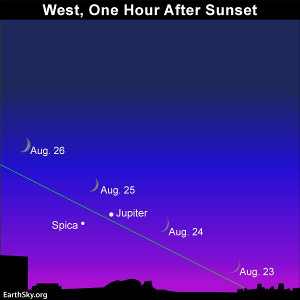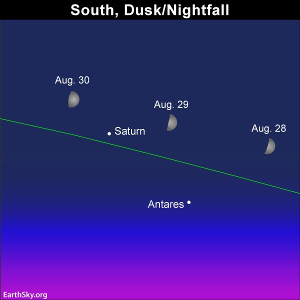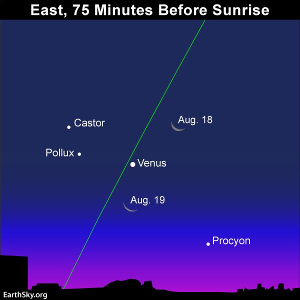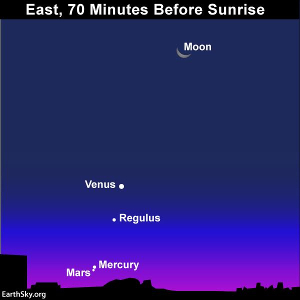|
August guide to the bright planets |
|
August 1, 2017 |
By Bruce McClure and Deborah Byrd
EarthSky.org
Three of the five bright planets – Jupiter,
Saturn and Venus – are easy to see in August
2017. Bright Jupiter is the first “star” to pop
into view at nightfall and stays out until
mid-to-late evening. Golden Saturn is highest up
at nightfall and stays out until late night.
Brilliant Venus rises before the sun, shining in
front of the constellation Gemini the Twins for
most of the month.
Meanwhile, Mercury will be hard to catch after
sunset from northerly latitudes, yet fairly easy
to spot from the Southern Hemisphere. And – for
all of Earth – Mars sits deep in the glare of
sunrise all month long, and probably won’t
become visible in the morning sky until
September 2017.
 |
| The waxing
crescent moon shines in the vicinity of
Jupiter (and the star Spica) for several
days, centered on or near August 25. |
Jupiter reached opposition on April 7. That is,
it was opposite the sun as seen from Earth then
and so was appearing in our sky all night.
The giant planet came closest to Earth for 2017
one day later, on April 8. Although Jupiter
shone at its brightest and best in April, it’ll
still be the brightest starlike object in the
evening sky!
Overall, Jupiter beams as the fourth-brightest
celestial body, after the sun, moon and Venus.
In August, Jupiter shines at dusk and evening;
meanwhile, Venus appears only in the
predawn/dawn sky.
Watch for the moon to join up with Jupiter for
several days, on August 23, August 24 and August
25.
From the Northern Hemisphere, Jupiter appears
fairly low in the southwest to west as darkness
falls; and from the Southern Hemisphere, Jupiter
appears rather high up in the sky at nightfall.
From all of Earth, Jupiter sinks in a westerly
direction throughout the evening, as Earth spins
under the sky. In early August, at mid-northern
latitudes, Jupiter sets in the west around
mid-evening (roughly 10 p.m. local time or 11
p.m. daylight-saving time); and by the month’s
end, Jupiter sets around nightfall (about one
and one-half hours after sunset).
Jupiter stays out longer after sunset at more
southerly latitudes. At temperate latitudes in
the Southern Hemisphere, Jupiter sets in the
west at late evening in early August, and around
mid-evening by the month’s end.
Jupiter shines in front of the constellation
Virgo, near Virgo’s sole first-magnitude star,
called Spica.
If you have binoculars or a telescope, it’s
fairly easy to see Jupiter’s four major moons,
which look like pinpricks of light all on or
near the same plane.
They are often called the Galilean moons to
honor Galileo, who discovered these great Jovian
moons in 1610. In their order from Jupiter,
these moons are Io, Europa, Ganymede and
Callisto.
These moons orbit Jupiter around the Jovian
equator. In cycles of six years, we view
Jupiter’s equator edge-on.
So, in 2015, we were able to view a number of
mutual events involving Jupiter’s moons, through
high-powered telescopes. Starting in late 2016,
Jupiter’s axis began tilting enough toward the
sun and Earth so that the farthest of these four
moons, Callisto, has not been passing in front
of Jupiter or behind Jupiter, as seen from our
vantage point.
This will continue for a period of about three
years, during which time Callisto is perpetually
visible to those with telescopes, alternately
swinging above and below Jupiter as seen from
Earth.
 |
| Let the moon
guide your eye to the planet Saturn and
the star Antares on August 28, 29 and
30. |
Saturn reached its yearly opposition on June 15,
2017. At opposition, Saturn came closest to
Earth for the year, shone brightest in our sky
and stayed out all night. It was highest up at
midnight, midway between sunset and sunrise.
In August 2017, Saturn shines higher in the sky
at nightfall than it did in June or July.
Moreover, Saturn transits – climbs its highest
point for the night at dusk or early evening – a
few hours earlier than it did in July 2017.
So, if you’re not a night owl, August may
actually present a better month for viewing
Saturn, which is still shining at better than
first-magnitude brightness.
Look for Saturn as soon as darkness falls.
It’s in the southern sky at dusk or nightfall as
seen from Earth’s Northern Hemisphere, and high
overhead at early evening as viewed from the
Southern Hemisphere. Your best view of Saturn,
from either the Northern or Southern Hemisphere,
is around nightfall because that’s when Saturn
is highest up for the night.
Be sure to let the moon guide you to Saturn and
the nearby star Antares on August 2, and then
again at the month’s end: August 28, August 29
and August 30.
Saturn, the farthest world that you can easily
view with the eye alone, appears golden in
color. It shines with a steady light.
Binoculars don’t reveal Saturn’s gorgeous rings,
by the way, although binoculars will enhance
Saturn’s color.
To see the rings, you need a small telescope. A
telescope will also reveal one or more of
Saturn’s many moons, most notably Titan.
Saturn’s rings are inclined at nearly 27-degrees
from edge-on, exhibiting their northern face. In
October 2017, the rings will open most widely
for this year, displaying a maximum inclination
of 27-degrees.
As with so much in space (and on Earth), the
appearance of Saturn’s rings from Earth is
cyclical.
In the year 2025, the rings will appear edge-on
as seen from Earth. After that, we’ll begin to
see the south side of Saturn’s rings, to
increase to a maximum inclination of 27o by May
2032.
 |
| The waning
crescent moon swings close to the
dazzling planet Venus on August 18 and
19. |
Venus is always brilliant and beautiful, the
brightest celestial body to light up our sky
besides the sun and moon. If you’re an early
bird, you can count on Venus to be your morning
companion until nearly the end of 2017.
Venus reached a milestone as the morning “star”
when it swung out to its greatest elongation
from the sun on June 3, 2017.
At this juncture, Venus was farthest from the
sun on our sky’s dome, and the telescope showed
Venus as half-illuminated in sunshine, like a
first quarter moon. For the rest of the year,
Venus will wax toward full phase.
Enjoy the picturesque coupling of the waning
crescent moon and Venus in the eastern sky
before sunrise on August 18 and August 19.
From mid-northern latitudes (U.S. and Europe),
Venus rises about three hours before the sun
throughout the month.
Mars transitioned out of the evening sky and
into the morning sky on July 27, 2017, at which
juncture Mars was on the far side of the sun at
what astronomers call superior conjunction.
 |
| Before
sunrise on September 16,draw an
imaginary line from the waning crescent
moon through the dazzling planet Venus
to find the planets Mercury and Mars in
conjunction near the horizon. Binoculars
may come in handy! |
Look for Mars to emerge in the east before dawn
in mid-September or October 2017. The
conjunction of Mars and Venus on October 5,
2017, will likely present the first view of Mars
in the morning sky for many skywatchers.
Exactly one year after Mars’s superior
conjunction on July 27, 2017, Mars will swing to
opposition on July 27, 2018.
This will be Mars’s best opposition since the
historically close opposition on August 28,
2003. In fact, Mars will become the
fourth-brightest heavenly body to light up the
sky in July 2018, after the sun, moon and the
planet Venus.
It’s not often that Mars outshines Jupiter,
normally the four-brightest celestial object.
When we say Mercury is visible in the evening
sky, we’re really talking about the Southern
Hemisphere. For the Southern Hemisphere, the
year’s best evening apparition of Mercury
happened in July 2017, but the tail end of this
favorable apparition extends into the first week
or two in September.
Mercury is tricky. If you look too soon after
sunset, Mercury will be obscured by evening
twilight; if you look too late, it will have
followed the sun beneath the horizon.
Watch for Mercury low in the sky, and near the
sunset point on the horizon, being mindful of
Mercury’s setting time.
Throughout August, Mercury will move closer to
the sunset day by day, and then will pass behind
the sun at superior conjunction on August 26,
2017. At superior conjunction, Mercury leaves
the evening sky to enter the morning sky.
The Northern Hemisphere will enjoy a favorable
morning apparition of Mercury in September 2017.
For a fun sky watching challenge, try to glimpse
Mercury and Mars in the east just as nightfall
is giving way to dawn on or near September 16.
You may need binoculars to view Mars next to
Mercury!
What do we mean by bright planet? By bright
planet, we mean any solar system planet that is
easily visible without an optical aid and that
has been watched by our ancestors since time
immemorial.
In their outward order from the sun, the five
bright planets are Mercury, Venus, Mars, Jupiter
and Saturn. These planets actually do appear
bright in our sky. They are typically as bright
as – or brighter than – the brightest stars.
Plus, these relatively nearby worlds tend to
shine with a steadier light than the distant,
twinkling stars. You can spot them, and come to
know them as faithful friends, if you try. |
|
Questions or comments about this
article?
Click here to e-mail! |
|
|
|
|

